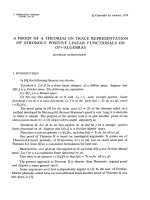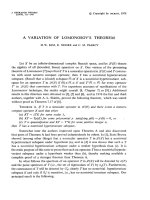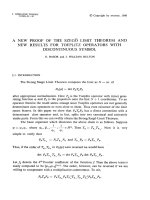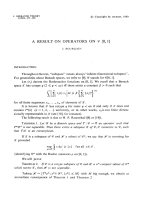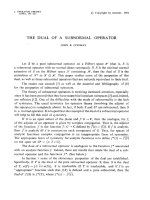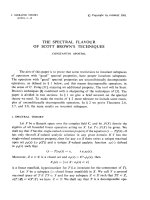Báo cáo toán học: "A 2-COLORING OF [1, N ] CAN HAVE (1/22)N 2 + O(N ) MONOCHROMATIC SCHUR TRIPLES, BUT NOT LESS" potx
Bạn đang xem bản rút gọn của tài liệu. Xem và tải ngay bản đầy đủ của tài liệu tại đây (92.51 KB, 4 trang )
A 2-COLORING OF [1,N] CAN HAVE (1/22)N
2
+ O(N) MONOCHROMATIC
SCHUR TRIPLES, BUT NOT LESS!
Aaron Robertson and Doron Zeilberger
1
Department of Mathematics, Temple University, Philadelphia, PA 19122, USA
,
Submitted: March 3, 1998; Accepted: March 25, 1998
Abstract
: We prove the statement of the title, thereby solving a $100 problem of Ron Graham.
This was solved independently by Tomasz Schoen.
Tianjin, June 29, 1996: In a fascinating invited talk at the SOCA 96 combinatorics conference
organized by Bill Chen, Ron Graham proposed (see also [GRR], p. 390):
Problem ($100): Find (asymptotically) the least number of monochromatic Schur triples {i, j, i+
j} that may occur in a 2-coloring of the integers 1, 2, ,n.
By naming the two colors 0 and 1, the above is equivalent to the following
Discrete Calculus Problem: Find the minimal value of
F (x
1
, ,x
n
):=
1≤i<j≤n
i+j≤n
[ x
i
x
j
x
i+j
+(1−x
i
)(1 − x
j
)(1 − x
i+j
)],
over the n-dimensional (discrete) unit cube {(x
1
, ,x
n
)|x
i
=0,1}. We will determine all local
minima (with respect to the Hamming metric), then determine the global minimum.
Partial Derivatives: For any function f(x
1
, ,x
n
)on{0,1}
n
define the discrete partial deriva-
tives ∂
r
f by ∂
r
f (x
1
, ,x
r
, ,x
n
):=f(x
1
, ,x
r
, ,x
n
)−f(x
1
, ,1−x
r
, ,x
n
).
If (z
1
, ,z
n
) is a local minimum of F , then we have the n inequalities:
∂
r
F (z
1
, ,z
n
)≤0 , 1≤r ≤n.
A purely routine calculation shows that (below χ(S)is1(0)ifSis true(false))
∂
r
F (x
1
, ,x
n
)=
(2x
r
−1)
n
i=1
x
i
+
n−r
i=1
x
i
− (n−
r
2
) − χ(r>
n
2
)−(2x
r
−1) +x
r
χ(r>
n
2
)+1−(x
r
2
+x
2r
)χ(r≤
n
2
)
.
Since we are only interested in the asymptotic behavior, we can modify F by any amount that is
O(n). In particular, we can replace F (x
1
, ,x
n
)by
G(x
1
, ,x
n
)=F(x
1
, ,x
n
)+
n/2
i=1
x
i
(x
2i
− 1) −
1
2
n
i=1
x
i
.
1
Supported in part by the NSF.
Mathematics Classification Numbers: Primary: 05D10, 05A16; Secondary: 04A20
1
the electronic journal of combinatorics 5 (1998), #R19 2
Noting that (2x
r
− 1)
2
≡ 1and(2x
r
−1)x
r
≡ x
r
on {0, 1}
n
,weseethatfor1≤r≤n,
∂
r
G(x
1
, ,x
n
)=(2x
r
−1)
n
i=1
x
i
+
n−r
i=1
x
i
− (n −
r
2
) −
1
2
χ(r ≤ n/2)
−
1
2
χ(r ≤ n/2) − 1/2.
Let k =
n
i=1
x
i
. By symmetry we may assume that k ≥ n/2. Since at a local minimum (z
1
, ,z
n
)
we have ∂
r
G(z
1
, ,z
n
)≤0, it follows that any local minimum (z
1
, ,z
n
) satisfies the
Ping-Pong Recurrence:Let
H
c
(y):=
0, if y ≥ c;
1, if y<c.
For r = n, n − 1, ,n−n/2 +1
z
r
=H
1/2
k−n+
r
2
+
n−r
j=1
z
j
, (Right V olley)
z
n−r+1
= H
1
2k − n − 1/2+
n−r+1
2
−
n
j=r
z
j
, (Left V olley)
and if n is odd then z
(n+1)/2
= H
1/2
(k − n +
n+1
4
+
(n−1)/2
j=1
z
j
).
These equations uniquely determine z (if it exists), in the order z
n
,z
1
,z
n−1
,z
2
, Whenwesolve
the Ping-Pong recurrence we forget the fact that
n
i=1
z
i
= k. Most of the time, the unique solution
will not satisfy this last condition, but when it does, we have a genuine local minimum. Note that
any local minimum must show up in this way.
The Solution of the Ping-Pong Recurrence: By playing around with the Maple package RON
(available from either author’s website), we were able to find the following explicit solution, for n
sufficiently large, to the Ping-Pong recurrence. As usual, for any word (or letter) W, W
m
means
‘W repeated m times’.
Let w =2k−n,k>n/2 (the case k = n/2 is treated seperately). Then 0 <w≤n.Ifw≥n/2
then the (only) solution is 0
n
.Ifw<n/2, then let s be the (unique) integer 0 ≤ s<∞,that
satisfies n/(12s + 14) ≤ w<n/(12s +2).
Case I: If n/(12s +8)≤w<n/(12s + 2) then the unique solution is
0
n
2
1
n−
n
2
−w−1
0
w+1
for s =0;
0
4w
(1
6w−1
0
6w−1
)
s−1
2
1
n
2
−(6s−2)w+s−1
0
n−
n
2
−(6s+1)w+s−1
1
6w−1
(0
6w−1
1
6w−1
)
s−1
2
0
w+1
for s odd;
0
4w
(1
6w−1
0
6w−1
)
s−2
2
1
6w−1
0
n
2
−(6s−2)w+s−1
1
n−
n
2
−(6s+1)w+s−1
(0
6w−1
1
6w−1
)
s
2
0
w+1
otherwise.
Case II: If n/(12s + 14) ≤ w<n/(12s + 8) then the unique solution is
0
4w
(1
6w−1
0
6w−1
)
s−1
2
1
6w−1
0
n−(12s+5)w+2s−1
1
6w−1
(0
6w−1
1
6w−1
)
s−1
2
0
w+1
for s odd;
0
4w
(1
6w−1
0
6w−1
)
s
2
1
n−(12s+5)w+2s−1
(0
6w−1
1
6w−1
)
s
2
0
w+1
for s even.
2
the electronic journal of combinatorics 5 (1998), #R19 3
Case III: if w = 0 (i.e. s = ∞), the unique solution is
1(0
3
1
3
)
k/6
1
2
(0
3
1
3
)
(k−6)/6
0
3
if k ≡ 0(mod6);
1(0
3
1
3
)
(k−1)/6
01
3
(0
3
1
3
)
(k−7)/6
0
3
if k ≡ 1(mod6);
1(0
3
1
3
)
(k−2)/3
0
3
if k ≡ 2(mod6);
1(0
3
1
3
)
(k−3)/6
0
2
(0
3
1
3
)
(k−3)/6
0
3
if k ≡ 3(mod6);
1(0
3
1
3
)
(k−4)/6
0
3
1(0
3
1
3
)
(k−4)/6
0
3
if k ≡ 4(mod6);
1(0
3
1
3
)
(k−2)/3
0
3
if k ≡ 5(mod6).
Proof: Routine verification!
Now it is time to impose the extra condition that
n
i=1
z
i
= k (= (w + n)/2). With Case I we get
a contradiction of the applicable range of w, but Case II yields that w =
n+2(s+1)
12s+11
,whichisalocal
minimum for n sufficiently large. Case III gives a local minimum when k ≡ 0, 1 (mod 6). Hence
The Local Minima Are:
Z
s
:= 0
4w
s
(1
6w
s
−1
0
6w
s
−1
)
s
2
1
6w
s
−3
(0
6w
s
−1
1
6w
s
−1
)
s
2
0
w
s
+1
for 0 ≤ s<∞(where w
s
:=
n+2(s+1)
12s+11
),
Z
0
∞
=1(0
3
1
3
)
k/6
1
2
(0
3
1
3
)
(k−6)/6
0
3
for w =0andk≡0 (mod 6), and
Z
1
∞
=1(0
3
1
3
)
(k−1)/6
01
3
(0
3
1
3
)
(k−7)/6
0
3
for w =0andk≡1(mod6).
A routine calculation [R] shows that for 0 ≤ s<∞
F(Z
s
)=
12s +8
16(12s + 11)
n
2
+ O(n),
which is strictly increasing in s. An easy calculation shows F (Z
0
∞
)=F(Z
1
∞
)=(1/16)n
2
+ O(n).
And The Winner Is: Z
0
=0
4n/11
1
6n/11
0
n/11
setting the world-record of (1/22)n
2
+ O(n).
Note: Tomasz Schoen[S], a student of Tomasz Luczak, has independently solved this problem.
An Extension: Here we note that our result implies a good lower bound for the general r-coloring
of the first n integers; if we r-color the integers (with colors C
1
C
r
) from 1 to n then the minimum
number of monochromatic Schur triples is bounded above by
n
2
2
2r−3
11
+ O(n).
This comes from the following coloring:
Color(i)=C
j
if
n
2
j
<i≤
n
2
j−1
for 1 ≤ j ≤ r − 2,
Color(i)=C
r−1
if 1 ≤ i ≤
4n
2
r−2
11
or
10n
2
r−2
11
<i≤
n
2
r−2
,
Color(i)=C
r
if
4n
2
r−2
11
<i≤
10n
2
r−2
11
.
REFERENCES
[GRR] R. Graham, V. R¨odl, and A. Rucinski, On Schur properties of random subsets of integers,
J. Number Theory 61 (1996), 388-408.
3
the electronic journal of combinatorics 5 (1998), #R19 4
[R] A. Robertson, On the asymptotic behavior of Schur triples,[www.math.temple.edu/~aaron].
[S]T.Schoen,On the number of monochromatic Schur triples, in preparation, [
kiel.de].
4
